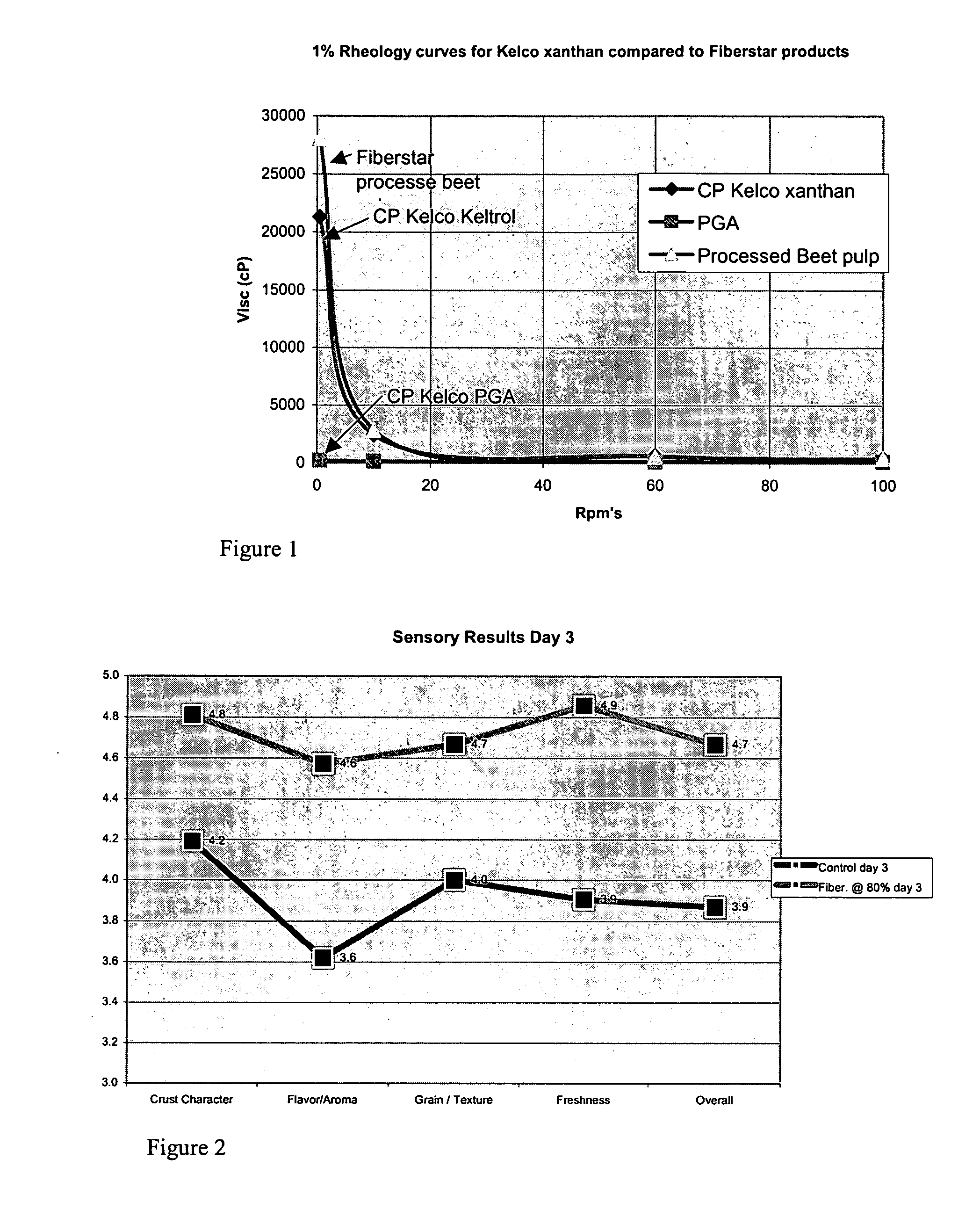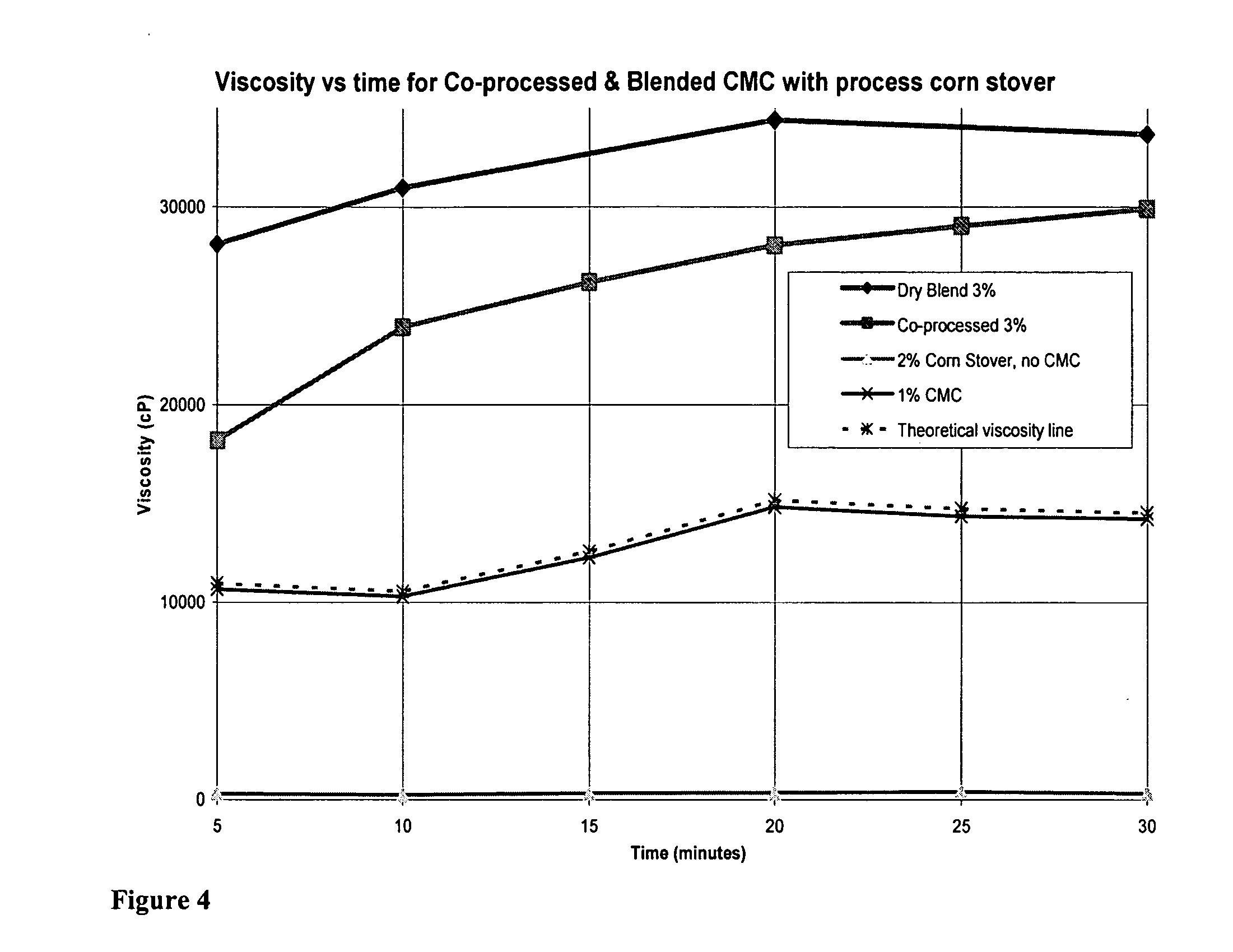Highly refined cellulosic materials combined with hydrocolloids
a technology of hydrocolloids and cellulosic materials, which is applied in the direction of sweetmeat, food preparation, and pulverizing with inorganic bases, etc., can solve the problems of reducing the surface area available for any subsequent reaction, reducing the ability of cellulose microfibers to intertwine, and reducing the structural integrity and/or strength of the final product, so as to increase the percentage of root and increase the percentage. , the effect of more discrimination
- Summary
- Abstract
- Description
- Claims
- Application Information
AI Technical Summary
Benefits of technology
Problems solved by technology
Method used
Image
Examples
example 1
[0073] Dried beet pulp shreds were obtained from a local feed store. The beet pulp was then ground to a powder using a disk mill or refiner. One particularly useful plate refiner is manufactured by Sprout Waldron of Muncy, Pa. and is Model 12-ICP. This plate refiner has a 60 horsepower motor that operates at 1775 rpm. After the dry materials were ground, they were soaked in hot water at 100° C. for 5 minutes at 5% solids, where the materials started to absorb moisture. The soaked materials were then washed with water in a screen cart to remove any unwanted particulate or soluble materials. After soaking, the materials were diluted to 3% solids and bleached in a 150 gal tank with agitation. The bleaching conditions were 15% hydrogen peroxide (based on dry matter weight), a pH of 11.5, and a temperature of 80° C. for one hour. After bleaching, the material was then washed in a screen cart. After bleaching, the materials were then refined again at 3% solids using the same refiner in th...
citrus examples 2-6
Example 2
[0074] Frozen washed orange pulp cells were obtained from Vita Pakt (Covina, Calif.). Hot water was added to the frozen pulp to thaw the pulp. After thawing, the materials were dewatered on a screen to remove any excess water and bring the solids content to 5%. The thawed and screened materials were refined using a Sprout Waldron disk mill (Muncy, Pa.), Model 12-ICP. The refined materials were then dispersed at 5% solids at 50,000 sec−1 shear rate using an IKA Dispax™ Reactor, Model DR 3-6A (Wilmington, N.C.). Viscosity was then measured using a Brookfield LVDV++ viscometer (Middleboro, Mass.) with cylindrical spindles.
example 3
[0075] Frozen washed orange pulp cells were obtained from Vita Pakt™ (Covina, Calif.). Hot water was added to the frozen pulp to thaw the pulp. After thawing, the materials were dewatered on a screen to remove any excess water and produce a pulp with a 5% solids content. The thawed and screened materials were refined at 5% solids using a Sprout Waldron diskmill (Muncy, Pa.), Model 12-ICP. The refined materials were then dispersed using an IKA Dispax™ Reactor, Model DR 3-6A (Wilmington, N.C.) at 5% solids. The dispersed materials were then homogenized one time at 8000 psi using an APV Gaulin high pressure homogenizer, Model MC(P)-45 (Wilmington, Mass.) at 5% solids. Viscosity was then measured using a Brookfield LVDV++ viscometer (Middleboro, Mass.) with cylindrical spindles.
PUM
| Property | Measurement | Unit |
|---|---|---|
| viscosity | aaaaa | aaaaa |
| pressure drop | aaaaa | aaaaa |
| temperature | aaaaa | aaaaa |
Abstract
Description
Claims
Application Information
 Login to View More
Login to View More - R&D
- Intellectual Property
- Life Sciences
- Materials
- Tech Scout
- Unparalleled Data Quality
- Higher Quality Content
- 60% Fewer Hallucinations
Browse by: Latest US Patents, China's latest patents, Technical Efficacy Thesaurus, Application Domain, Technology Topic, Popular Technical Reports.
© 2025 PatSnap. All rights reserved.Legal|Privacy policy|Modern Slavery Act Transparency Statement|Sitemap|About US| Contact US: help@patsnap.com



